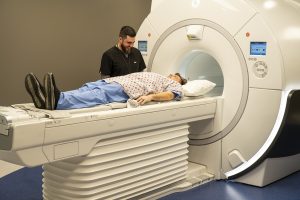Imaging
Our Mission
Our mission is to provide excellent patient care through diagnostic services and image-guided procedures. Patients should be comfortable and confident in the imaging services provided by the SDMG Imaging Department. Referring physicians and other health care professionals recognize the efficient clinical service at Slocum-Dickson, which is responsive to their needs and gives optimal patient care.

The Imaging Department is accredited by the American College of Radiology (ACR) in CT, MRI, PET/CT, Breast Ultrasound, General Ultrasound, and Mammography. ACR Accreditation is recognized as the gold standard in medical diagnostic imaging. ACR Accreditation demonstrates our commitment to providing the safest, best-quality care possible.
The Imaging Department provides a wide range of high-quality and efficient clinical diagnostic and therapeutic imaging procedures. Consultations and comprehensive radiologic evaluations of all types of clinical problems are available.
The department is staffed by Dana M. Zacharewicz, MD and Scott Peplinski, MD, board certified by the American Board of Radiology and New York State licensed technologists.
Hours of Service
Burrstone Campus
Weekdays:
7:30 am – 8:00 pm
Ultrasound:
Monday – Friday 7:30 am – 4:00 pm
CT:
Monday – Friday 8:00 am – 6:00 pm
Weekends:
9:00 am – 6:00 pm
Holidays:
Hours vary, please call ahead
(315) 798-1440
Business Park Campus
MRI:
Monday – Friday 7:00 am – 5:00 pm
Ultrasound & PET/CT:
Monday – Friday 7:30 am – 4:00 pm
Mammography:
Monday – Friday 7:30 am – 5:00 pm
Weekends:
Closed
Holidays:
Hours vary, please call ahead
(315) 798-1440
Diagnostic Radiology Offers a Full Scope of Services and Expertise in:
- Digital Mammography
- General Radiology
- Angiography
- Fluoroscopy
- CT Scanning
- Ultrasound
- PET/CT
- 3T MRI
- Bone Mineral Density
- Ductography
Radiology Tests
3D Digital Mammography
Digital Mammography is the latest technology system for early detection of breast cancer. The system makes mammograms quicker than ever before. A digital system means the mammogram image is displayed on a computer screen, rather than traditional film. Because of this, our radiologists are able to manipulate and enhance the computer image for greater clarity. This method improves detection capabilities, especially for women with dense breasts or those with breast implants.
Our Breast Imaging Center is staffed by Registered Mammography Technologists and includes private changing areas.
All equipment is under continuous state and federal quality assurance testing to assure the safety of patients and staff.
3T MRI
State-of-the-art 3T MRI is a scan used for medical imaging. It uses a magnetic field and radio waves to take pictures inside the body. MRI images the water in the body, which makes it especially helpful to collect pictures of soft tissue such as the brain, organs, muscles, tendons, cartilage, as well as blood vessels that don’t show up on X-ray examinations. This unit is not only a larger opening; it is faster with more innovative equipment for increased patient comfort and flexibility.
Arthrography
The Radiology Department offers Arthrography, which is an examination of the joints. One of our experienced Radiologists will inject the joint with a dye-like material or air to make viewing the soft tissue and joint structures easier. Arthrography is useful in detecting the causes of joint pain and can indicate a need for a joint replacement.
Bone Mineral Density
The skilled Radiologists at Slocum-Dickson can accurately measure bone mineral density. Patients will receive an X-ray, which will evaluate bone mineral density. This information is helpful in the diagnosis of bone health problems such as Osteoporosis, as well as assessing the risk of fractures.
CAT Scan
The Radiology Department is equipped with a 64-slice CT Scanner, which uses X-ray equipment to view a three-dimensional image of the body from different angles. This technology captures images of a beating heart in five heartbeats, an organ in 1 second, and a whole body scan in ten seconds, more than twice as fast as a conventional CT Scanner. This speed is especially helpful in shortening breath-hold exams like Low Dose Lung CT screenings. Our radiologists use the information gathered from the CT scan to detect the cause of many different types of pain, discomfort, and other pathologies.
Ductography
The Radiology Department offers Ductography, also known as Galactography. Our Radiologists are highly trained and qualified to perform this specialized procedure. Ductography is a special type of mammography with enhanced contrast used for imaging breast ducts. Ductography can help detect the cause of abnormal nipple discharge and cancerous or non-cancerous tumors.
Fluoroscopy
This imaging technique uses X-rays to view an image of an organ while it is functioning. This method of imaging is very useful in examining the colon and rectum. It is one of the most effective ways to detect a blockage in the gastrointestinal tract.
PET-CT
PET-CT is a diagnostic imaging procedure combining pictures from a (PET) scan and a (CT) can. The PET and CT scans are done simultaneously with the same machine. PET-CT can image almost the whole body at once. The combined scans give more detailed pictures of areas inside the body than either scan gives by itself. A PET-CT scan may be used to help diagnose diseases such as cancer, plan treatment, or find out how well current treatment is working. Our unit is the most modern and technologically advanced locally.
Ultrasound
This is a method of obtaining images of the body by recording reflected high-frequency sound waves, which are displayed as a real-time image. No X-ray is involved in an ultrasound. Ultrasound imaging is useful in examining internal organs such as the heart, liver, gallbladder, spleen, pancreas, kidneys, bladder, blood vessels, obstetrics, breast tissue, and some tendons.
